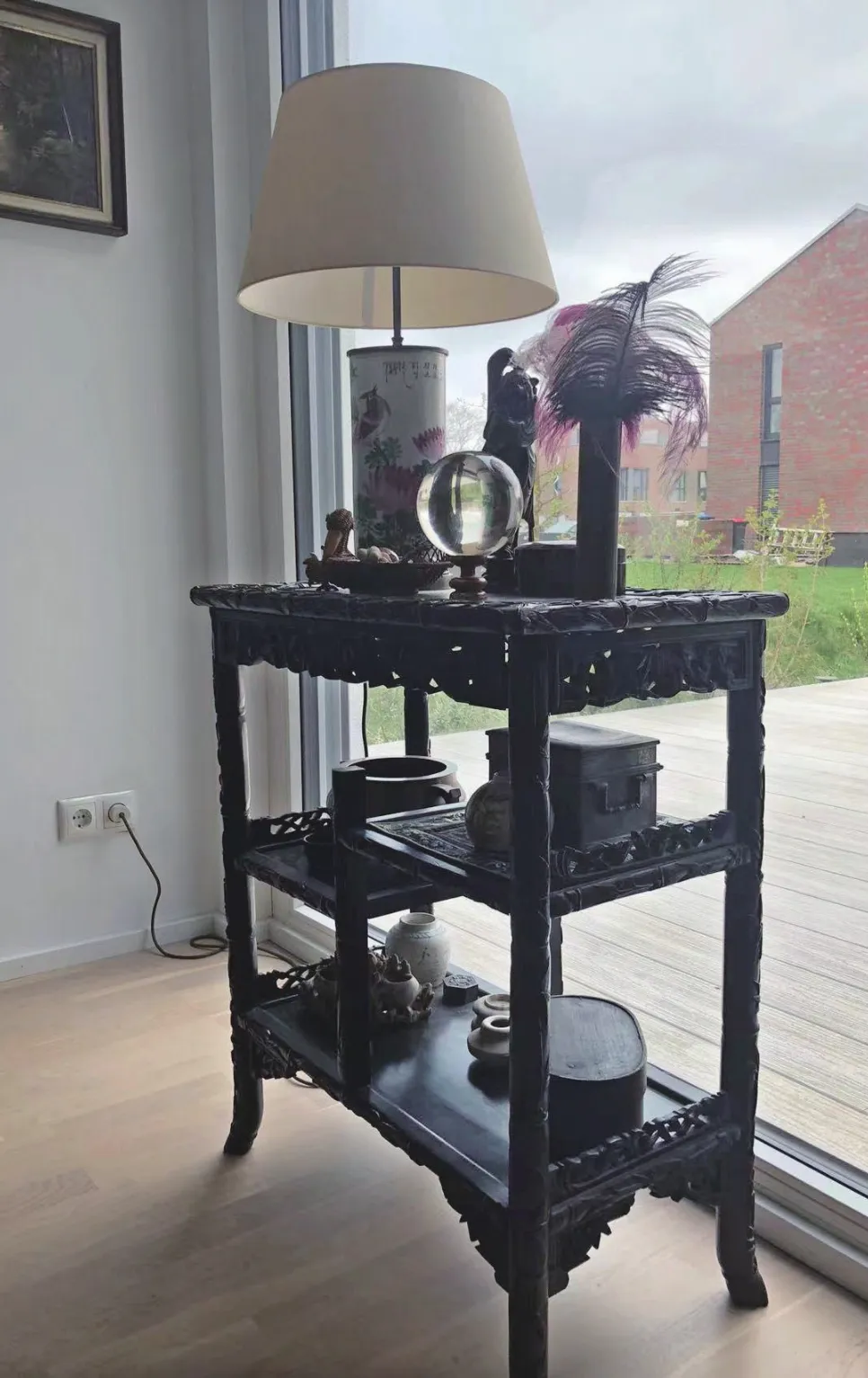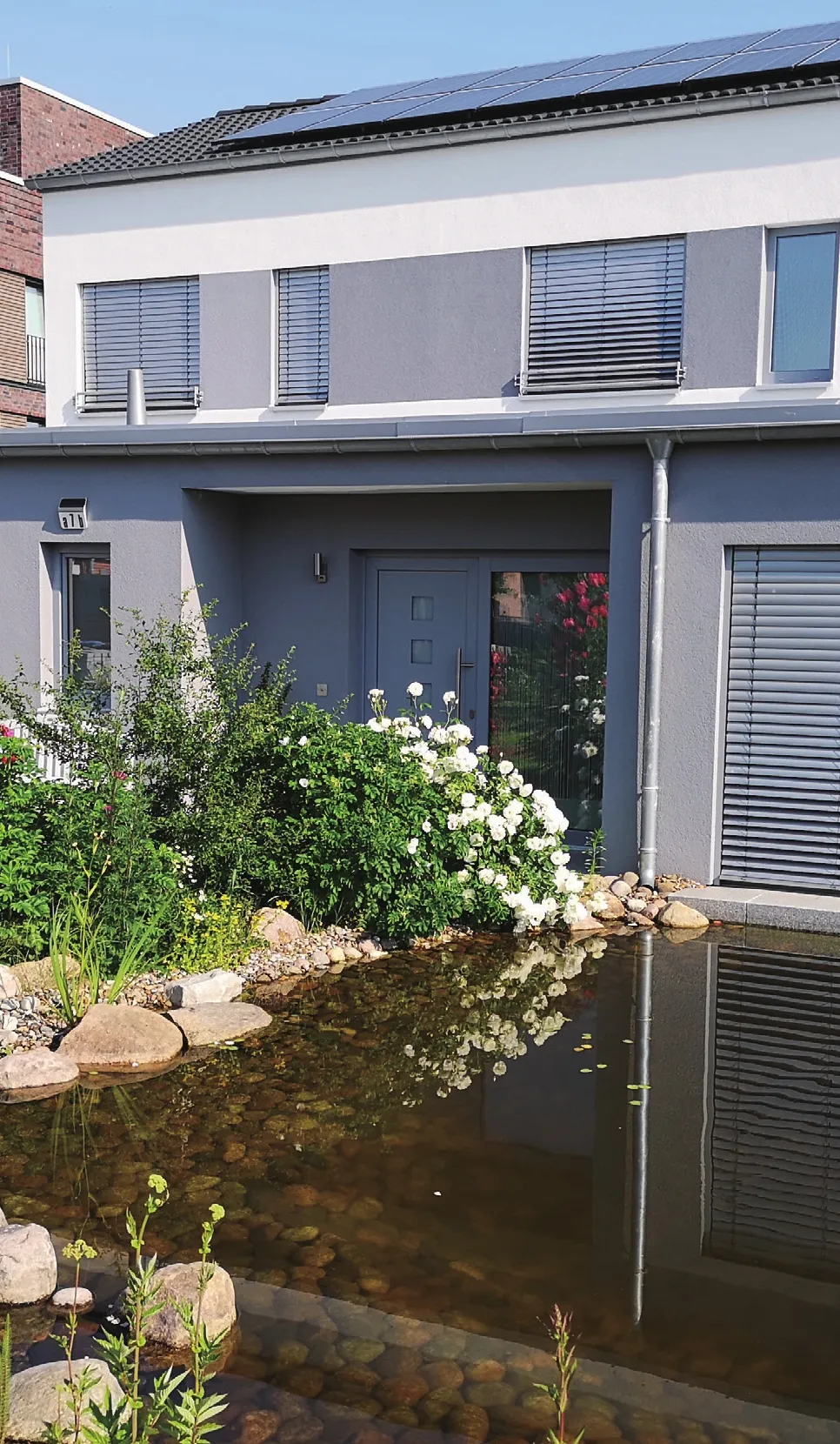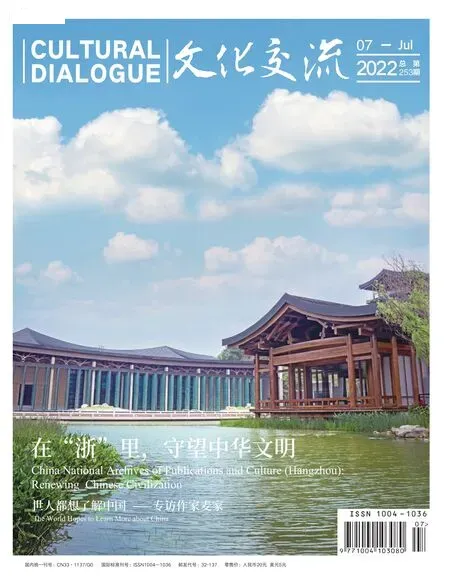瀚为把中国文化带到德国传播
文 /韩 兢

瀚为与他的藏书。Hans and his library.
德国汉学家许瀚为博士(这是他根据自己德文名字Hans Wilm Schütte 而取的中文名字)居住在汉堡易北河南部,一个叫Neugraben (新沟渠)的小镇上,小区名叫鸟巢。
瀚为博士的家在周边居民看来就是“豪宅”,不仅因为房子大,还因为他的院子。他在院子中间挖了一个约28平方米左右的水池,水池清澈见底,底部铺满了鹅卵石,还修了一座形似江南小桥的石头桥,水池里小小的金鲤鱼在游动,池边搭建了一个中国式的白色小亭子。
每当他的中国邻居吴朝阳走进这个院子时,熟悉的中国文化气息扑面而来:一个中国江南小园林!
吴朝阳说,瀚为博士对中国的了解着实比她这个地道的中国人要深刻得多。如今70多岁的他,依然在中国和德国之间奔走,依然在写书,他是德国人,但又命运般神奇地浸染了很多中国的色彩。
此前,他将其撰写的8本德语版有关中国文化的书籍捐赠给了杭州国家版本馆,其中有一本是他在走访浙江时留下的图片和采访笔记。
许多与瀚为有交往的华人华侨,看到这位德国老人用一生时间研究中国、行走中国、书写中国,好奇和敬畏之情油然而生。
和中国结缘
瀚为的命运和中国交织在一起,是从1968年高中毕业那个暑假开始的。
那个夏天,十几岁的他来到一个书籍博览会。在这个熙熙攘攘、热热闹闹的博览会上,这位德国少年的注意力被一本中文书吸引了。他当然完全不知道这本书在写什么,但就是很喜欢书上的那些字,看上去像一幅幅的画,但却是文字,和欧洲的文字完全不同的文字。

瀚为家祖传的中国画师的绘画。The portrait painting of Hans’s ancestor, painted by a Chinese painter.
瀚为早就想学一门和欧洲语言完全不同的语言,这奇特的文字激发起他的探索欲。
瀚为家从他小时候起就有一幅特别的画。画中女子神态宁静,身穿很典型的欧洲服饰,坐在一张精致的雕花木椅上。这幅画悬挂在屋子里,影响着瀚为家族一代又一代的人,好像牵动着这个家族和中国的缘分。因为这幅画就出自一位华人画师之手,是翰为祖先前往中国时,让当时的中国画师把自己随身携带的母亲照片画了出来。
大学时偶然开始的专业一不留神成了瀚为一生的选择。他大学本科、硕士、博士都学习了汉学。读完博士后,他在汉堡大学里教授汉学。教授汉学的时候,他感觉到,当时大部分德国学生对中国很感兴趣,对中国的古代文化也很有兴趣,所以他和他们一起探讨中国,研究中国成了他生命里一件很享受的事情。
在汉堡大学工作了将近十年后,尽管他内心里很想继续从事教学工作,但出于各种原因,他最后还是决定成为一名自由职业者。
在中国行走
自由撰稿人的生活其实不好过。“工作多,酬金少,后来才慢慢好了。”瀚为说。
因为熟悉中文,熟悉中国历史文化,瀚为被一家出版社看上了。出版社邀请瀚为写一些有关中国旅游指南一类的书。他也因此开启了德国和中国的往返生活。
有时候是为了写旅游书,有时候是带德国人来中国旅游,他跑了很多地方,北京、香港是跑得最多的。而待得最久的一定是北京。
他有一本书,书名就是《北京》,还写了一本书叫《文学世界里的北京》,他把全世界作家是怎么写北京的都集中到了一本书上,有诗歌、散文、小说等。这本书更像是带你在以北京为主题的文学世界里畅游,用不同的视角去看这个千年古都。
“从中国传统文化的角度来讲,我觉得北京原来是最有代表性的,几百年以前就有外国人到了北京,不同的外国人描写了北京不同的情况,在北京住过的中国作家也不少,这些方面别的城市恐怕都比不上北京。”瀚为说。不过他也很直接地表示,“现在的北京太现代化了,但有一些四合院里面的餐厅或宾馆还是很不错,有好的传统气氛”。
写旅游指南不是一蹴而就的事,因为当地的环境会不断地变化,瀚为需要不断地去更新写好的书,所以他也在一遍一遍地游历中国。他说,我来中国大概有四十多趟,除了宁夏没有去过,其他每个省都去过了。
有一次在北京做实地调查时,一位从东北来的四十多岁的中国朋友打算陪着他一起走走看看,他们从早走到了晚。到了晚上,那个朋友忍不住要放弃,因为他实在走不动了。
而六十岁出头的瀚为依然是精神矍铄,他神采奕奕地对那个朋友说,这只是他很普通很正常的一天。
与浙江之情
瀚为的邻居吴朝阳是他晚年一起喝茶聊天的好伙伴。
吴朝阳是浙江东阳人,来到德国之前是一位历史老师。
当吴朝阳一家的户主名牌树立在自己房子门口时,瀚为就注意到他的中国邻居了。他特意找到了房屋中介,要来了吴朝阳的邮件。出于对中国文化的喜爱,他想进一步和这位中国邻居有更多的交流。
吴朝阳受邀第一次走进瀚为教授的家。她说,她顿时觉得自己家和瀚为的比较起来,简直是“家徒四壁”,“他的家一楼看起来好像是个美术馆,二楼是个图书馆”。
在一楼的走廊,一面墙上挂着郑板桥画的竹子,另一面墙上挂着家族里传承了上百年的油画。客厅的白墙上挂着京剧脸谱的漆雕画,窗户上贴着一扇小小的中国木雕窗。
而走进他二楼的书房,更好像走进了一个中国古籍馆。从地面做到顶的书架上,整齐地叠着北宋史、元史、三国志、明史、汉书,甚至还有人民出版社早年出版的《中国思想通史》。
因为吴朝阳的关系,让瀚为和浙江有了更深的联系。
2012年和2013年,浙江出版联合集团邀请瀚为到浙江旅游采访。在年轻大学生的陪伴下,他一共花了三个月的时间,两次走访浙江各地。之后他写成了《显微镜下的中国现代省份的报告》这本书,这本书在G20时还被翻译成英文出版过。
“我对浙江很多有历史味道的小地方印象很深,是一些小城市,外地人不太知道,但保存得很有特色。在这些地方还能感受到传统的生活,现在还能回忆起来的有龙门镇、王村口、临海的古城墙,等等。”他特别喜欢的一个地方是诸葛村,三次带着旅行团去那里玩。“去的德国朋友们都挺喜欢的。”他觉得,这些地方被人为改造的痕迹很少,走访的时候有与古时对话的感觉。
浙江的佛教文化很丰富,这也让瀚为印象深刻。他对佛教一直很有兴趣,写了一本与佛教文化相关的书籍。在浙江采访时,他常常发现,浙江百姓很喜欢兴建佛像和佛寺。在他记忆里,印象最深的是有一次去天台山上的一座很小、很少有人去的寺庙,叫智者塔院,“它躲在森林里,很闭塞,很安静”。而这样人少小众的文化场所,恰恰是他这位想要寻找历史遗迹的学者所喜欢的。
爱中国茶文化
瀚为出生于靠近荷兰的小城镇Varel。这个小镇的居民,几乎每天早上起来都要喝茶,晚上也要喝茶;冬天要喝茶,夏天也要喝茶。所以,喝茶对于瀚为来说,就像每天要吃饭一样,是最普通自然的事情。
自从瀚为成为一名汉学家后,他依旧四季喝茶,但有一点不一样了—那就是冬天喝西式茶,夏天开始喝中式茶;冬天喝黑茶加奶加糖,夏天喝普洱乌龙等。“因为冬天需要比较多的热量。”瀚为笑道。
他依稀记得,第一次喝中式茶是在1973年。那时候,他初到香港,发现香港的茶文化主要部分不是茶水,而是当地的点心。香港人说“饮茶”的意思,其实是喝着茶吃点心。他非常喜欢这种茶文化,和欧州的风格有点像。当时茶馆在香港比在现在更加流行,大的茶楼有几层楼,早上和中午都非常热闹。
在中国游历期间,有时候热情的中国朋友会拉着他喝茶,他本期待着一场隆重的喝茶仪式即将开始,没想到程序要简单很多。他似乎有点小情绪:“起码应该是用瓷器装的。”言语之间,一个文化学者的坚持和执拗又出来了。
直到今天,73岁的他依然坚持喝中式茶和西式茶用不同的茶具。喝欧式茶时,用的是一只有上百年历史的带托盘有玫瑰花纹的瓷杯;而喝中式茶,用的则是一整套白瓷茶具。
每次和中国邻居喝茶,喝茶的架势都让曾为历史老师的吴朝阳连连感叹,中国的传统文化竟然在一个德国人身上传承得这么好。
他在院子里还准备专门修建一座喝茶的亭子,目前还是一个白色钢结构。他在亭子旁边种上了葡萄藤,等到葡萄绿叶爬满亭子的时候,他说要邀请他的亲朋好友,包括吴朝阳,来亭子里喝茶。
在电话采访结束时,瀚为也邀请笔者等疫情过后去他在德国汉堡的江南小园林里喝茶,观鱼,聊中国文化,读中国古书。很想知道,当这位热爱中国文化的德国汉学家跟我们面对面聊天时,谁会是那个更了解中国传统文化的人呢?

瀚为家中有很多中式家具。Chinese-style furniture is seen everywhere in Hans’s home.
Dr. Hans-Wilm Schütte: A Sinologist and Cultural Ambassador
By Han Jing
Dr. Hans-Wilm Schütte, a German sinologist, lives in Neugraben, a small town in the south of Elbe, Hamburg. In a neighborhood called Bird’s Nest, his house is seen as a mansion by the local people, not only for its size, but also because of his courtyard. He dug a pond of 28 square meters in the middle, with its crystal clear water dotted by gold fishes and its bottom covered with pebbles. Above the pond, he built a stone bridge resembling those in China’s(south of the Yangtze River) area, and a white Chinese-style pavilion nearby.
Every time Wu Chaoyang, his Chinese neighbor, walks into this yard, she somewhat gets confused about her exact whereabouts. Has she returned to China? Wu said that Hans has a more profound understanding of China than her. Now in his 70s, he still travels between China and Germany, and writes books. Not long ago, he donated eight German-language books on Chinese culture to the China National Archives of Publications and Culture (Hangzhou), including one with the pictures and interview notes he recorded during his stay in Zhejiang.
His story with China began in the summer of 1968 when Hans graduated from high school. One day, in a bustling book fair, he was attracted by a book written in Chinese. He had no idea what the book was about, but the Chinese characters were so mesmerizing that he couldn’t take his eyes off them. They were like pictures, with the least resemblance of letters of alphabet. This triggered his curiosity as he had long desired to learn a language that was completely different from European ones.
Hans got to know his family heirloom as a young boy: a painting of a lady in a mild demeanor wearing a typical European dress and sitting on an exquisitely carved wood chair. When Hans’s ancestor visited China, he asked a Chinese painter to draw the picture of his mother based on the portrait he took with him.
Never did Hans himself think that Sinology would be his life pursuit. He chose Sinology as his undergraduate major by accident, but furthered it in his postgraduate and doctoral studies.He then taught Sinology at the University of Hamburg and found many German students very interested in China at that time, especially the ancient Chinese culture. After working in the university for almost a decade, he decided to become a freelancer,in spite of his strong passion for education.
Earning a living through writing is by no means easy. “I worked hard with little remuneration at the beginning. It took a while to get better,” Hans said. Well versed in the Chinese language, history and culture, he was offered a job to write travel guides about China for a publishing house. A life filled with round trips between Germany and China started.
Sometimes he traveled to gain inspiration for new books, and sometimes he brought Germans to China for a tour. He traveled to many places, Beijing and Hong Kong in particular. His longest stay was in Beijing, the thousand-year-old national capital, which materialized in his booksand(). He pooled how writers from all over the world wrote about Beijing in one book,in the forms of poetry, prose, novels, etc. Reading this book is like strolling in the literary world with Beijing as the theme.
“I think Beijing is the most representative of traditional Chinese culture. For hundreds of years, people from other countries have visited Beijing to describe this city. Many Chinese writers have lived in Beijing. No other cities can compare to Beijing in this regard,” Hans said. However, he added, “I don’t like Beijing so much anymore. You can only find the traditional vibe in some restaurants or hotels nested in, the quadrangle courtyards.”
A travel guide is not written overnight, as the local environment constantly changes. To update his books, Hans needs to travel to China many times. He said that he had been to China about forty times and reached almost every province except Ningxia. During a field investigation in Beijing, a Chinese friend in his forties from Northeast China came to his company for the work. They walked from morning to night. Finally, that friend was tired and said he couldn’t walk any more. On the contrary, Hans,who was then in his early 60s, was still in high spirits. He said, “This is an ordinary day for me.”
Wu Chaoyang was a good neighbor for Hans to drink tea and chat with in his later years. Wu is a native of Dongyang county,Zhejiang. Before coming to Germany, she was a history teacher.As soon as Wu put her family nameplate on the doorstep, Hans noticed this Chinese neighbor. He got Wu’s email address through the real estate agent. Out of love for Chinese culture, he wanted to know more about her.
When Wu was invited to his home for the first time, she felt her house was “utterly destitute” compared with Dr. Schütte’s. “His house looks like an art gallery on the first floor and a library on the second floor.” In the corridor, one finds a picture of bamboo on a wall painted by Zheng Banqiao (1693-1765), the noted painter and calligrapher, and a century-old oil painting on another wall. In the living room, there are lacquer carvings of Peking opera masks on the white wall, and a small Chinese wood carving window attached to the glass. His study on the second floor is more like a Chinese ancient book library. On the high bookshelf, one canfind annals of the various Chinese dynasties and even an early edition of
The friendship between Wu and Hans led to a deeper connection between him and Zhejiang. In 2012 and 2013, the Zhejiang Publishing United Group invited Hans to Zhejiang for interviews. He spent three months each time visiting every corner of Zhejiang, and finally completed, which was later translated into English and published during the G20 Summit held in Hangzhou.
“I am deeply impressed by many small places with historical flavors in Zhejiang. These special towns are not well known, but are well preserved. You can have a glimpse into the old life there.I can recall Longmen township, Wangcunkou village, the ancient city wall in Linhai, Cicheng township in Ningbo city,” he said.“One of my favorite places is Zhuge village. I took three tour groups there. They like it very much.” Hans thinks those places generally intact, and he can have a dialogue with the ancients.
He was surprised by the rich Buddhist culture in Zhejiang.He is interested in Buddhism and has written about its culture.Through his interviews, he found that local people liked to build Buddhist temples and statues. He has visited many monasteries and talked with monks and abbots. What impressed him most was a very small temple on the Tiantai Mountain called the Stupa of the Wise. “It is hidden in the forest, very secluded and quiet.” This is exactly what he has been looking for.
“Perhaps the local people in Zhejiang, who used to earn a living through fishing, have close exchanges with Japanese and other ethnic groups in Southeast Asia, and they are more openminded and willing to accept other cultures.”
Hans is also fascinated by the Chinese Tea culture. In Varel,a small town near the Netherlands, where he was born, “people drink tea almost every morning when they wake up, drink tea at night, and drink tea in winter and summer.” Therefore, drinking tea is a routine for him. As a Sinologist, he has changed his drinking habit a little bit — drinking Western tea in winter and Chinese tea in summer, in particular, dark green tea with milk and sugar in winter, and Pu’er tea and Oolong in summer. “You need more calorie for winter,” he laughed.

瀚为家的小院。The courtyard of Hans’s house.

